Hello, chaps!!
The vehicle for this article is the ubiquitous (in early stages of WWII) Vickers Light tank Mk. VIB. Let's get to know a little more about this brave and reliable British reconnaissance tank.
 |
| modified from IWM O 679 photo |
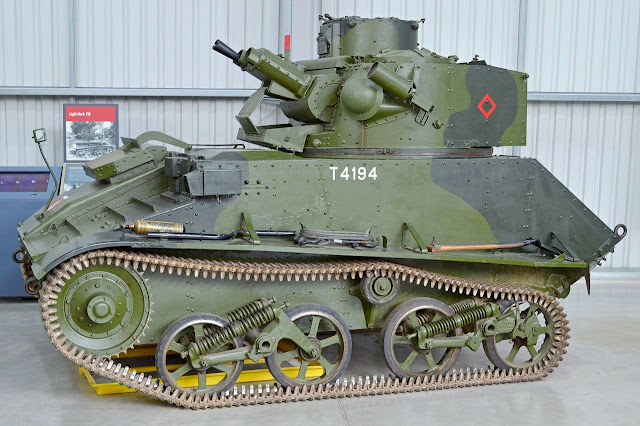 |
| Light tank Mk VIB with the colors of 4th/7th Dragoon Guards 2nd Infantry Division - British Expeditionary Force Battle of France -1940 - Bovington Museum |
 |
| Vickers Light tank Mk.VIB England - 1936 |
Development:
The Tank, Light, Mk VI (Vickers light tank Mk VI) was the sixth in the line of light tanks built by Vickers-Armstrongs for the British Army during the interwar period. The company had achieved a degree of standardization with their previous five models. See the lineage evolution (Mk.I to Mk. V) of these light tanks in the images below:
 |
| Light Tank Mark I (A4E4) with leaf springs suspension - Farnborough - 1929 |
,%201930%20%20KID%20321.jpg) |
| British Light Tank Mk I (A4E4) England - 1930 |
%20fitted%20with%20Horstman%20coil%20spring%20suspension%20KID%20322.jpg) |
| Light Tank Mk IA (A4E8) fitted with Horstman coil spring suspension |
%20KID%20470.jpg) |
| Light tank Mark IA (A4E10) showing tall turret with two machine guns (.50 and .303) and spring leaf suspension Lulworth - England |
 |
| Four Light tanks Mark IA were also built for trials in India. All feature modified Horstmann suspension - 1930 |
 |
| Light tank Mk.IIB with a two-man enlarged sloped turret. These tanks had been captured in large numbers during the Battle of Beda Fomm in February, 1941. Notice the modified Horstmann suspension. |
 |
| Vickers-Armstrongs built Light Tank Mark IIB identified by the petrol filler cap on the side, with early Horstman coil spring suspension, under trials, in England. |
 |
| Light tank Mk.IIB India pattern, with indian turret cupola and definitive modified Horstmann suspension, in need of a little help. |
 |
| Light tank Mk.III with colors of Egypt Army, in 1932. |
 |
| Light tank Mk.III in test fields |
 |
| Light tank Mk.IV in a violent stop. The high center of gravity and the suspension caused this weird roll. Trials in 102nd Officer Cadet Training Unit (102 OCTU) Sandhurst - August, 1940. |
 |
| Light tank Mk.IV in trials with Royal tank Corps - late 30´s |
 |
| Light tank Mk.V - 9th Queen’s Royal Lancers 1937. |
 |
| Light tanks Mk.V from 9th Queen’s Royal Lancers Trials in England - 1937 |
The Mark VI was an evolution of this family of tanks, being very similar to all of them, except in some aspects, such as the turret, which had been expanded in the Mk V to allow a three-man crew to operate the tank, was further expanded to give room in its rear for a wireless set.
 |
| Light Tank Mk. VIB - Canadian Armoured Corps Borden - Ontario - Canada - 1939 |
The weight of the tank was increased to 4.900 kg, which although heavier than previous models actually improved its handling characteristics, and an 88 horsepower (66 kW) Meadows engine was added to the model to increase its maximum speed to 56 km/h.
 |
| Meadows 1930s pamphlet on 6-cylinder engines |
 |
| Light Tank Mk VI from 13/18th Hussars undergoes repair work on its engine at a RASC vehicle workshop France, 3 January 1940 |
 |
| Modified Horstmann suspension installed in Light tank Mk. VI B |
 |
| The crew of a Light Tank Mk VIB cook their New Year´s Eve dinner by their vehicle 31 December 1940 |
 |
| .303 Vickers water cooled medium machine gun |
- The Vickers light tank Mk VI had the return roller in the top of the front bogie, with drum-type simplified turret cupola and no extensions on front fenders. Generally, they did not have grenade launchers on the sides of the turret.
 |
| Vickers light tank Mk.VI |
- The Vickers light tank Mk VI A had a return roller removed from the top of the front bogie and attached to the hull sides instead, and also possessed a faceted cupola. The presence of grenade launchers on the sides of the turret was standard. Notice the curved extensions on front fenders.
 |
| Vickers light tank Mk.VIA |
- The Vickers light tank Mk VI B was mechanically identical to the Mk VIA but with a few minor differences to make production simpler, including a one-piece armoured louvre over the radiator instead of a two-piece louvre, and a plain circular cupola instead of the faceted type.
 |
| Vickers light tank Mk.VIB |
 |
| External identification details between Mk.VI, Mk.VIA and Mk.VIB models. The Mk.VIC model is easily differentiated by the different armament |
- The Vickers light tank Mk VI B (India pattern) was a standard Mk VIB with small differences, such as the absence of the Commander´s circular turret cupola and sighting vane, replaced by a double hatch with periscope and a little deflector flap on front fenders. You don't notice the presence of the grenade launchers on the sides of the turret, either.
 |
| Vickers light tank Mk.VIB - India pattern |
 |
| External identification details between standard Mk.VIB and Mk.VIB India pattern. |
- The Vickers light tank Mk VI C, which was the last in the MK VI series, had the commander's cupola removed, wider bogies and three carburettors to improve engine performance; it was also more powerfully armed than the other models, replacing the .303 and .50 Vickers machine guns by co-axial 15 mm and 7.92 mm Besa machine guns.
 |
| 7.92 mm Besa light machine gun |
 |
| 15 mm Besa heavy machine gun |
 |
| 7.92 mm and 15mm Besa machine guns |
 |
| Vickers light tank Mk.VI C |
 |
Light Tanks Mk VIs roaring in an exercise in Maltese road. Foreground vehicle is a Mk VIC, with a Mk VIB parking in the trees. Malta - 24 May 1942 |
 |
box art from British Light Tank Mark.VI C (#72292) |
- The Tank, Light, AA Mk I ("Ack Ack" Mk I light tank) was built in the aftermath of the Battle of France and was intended to act as a counter-measure against attacks by German aircraft. It featured a hand-operated turret fitted with four 7.92 mm Besa machine guns.
 |
| Tank, Light, AA Mk I, in anti-aircraft readiness. Notice the chassis of Mk VIB version and yellow cammo. African Desert, 15 September, 42. |
- Tank, Light, AA Mk II ("Ack Ack" Mk II light tank) was produced which was mechanically similar but had improvements, such as better quality sights for the machine guns and a larger power-operated turret for better access and operational handling.
 |
| Final version of the Tank, Light, AA Mk II, with the upper deck lowered, which increased stability in the rotation of the tower. This "ack ack tank" wear a Mk VIB chassis... |
 |
| Light Tanks Mk VIB of the Royal Tank Corps on exercise near Petersfield, in Hampshire England - 1938 |
 |
| Vickers Medium tank Mk III - command version (A1E3) Salisbury Plain training area - 1935 |
 |
| Vickers light tank Mk VI of 13/18th Royal Hussars, France, near Arras - 12 October 1939 |
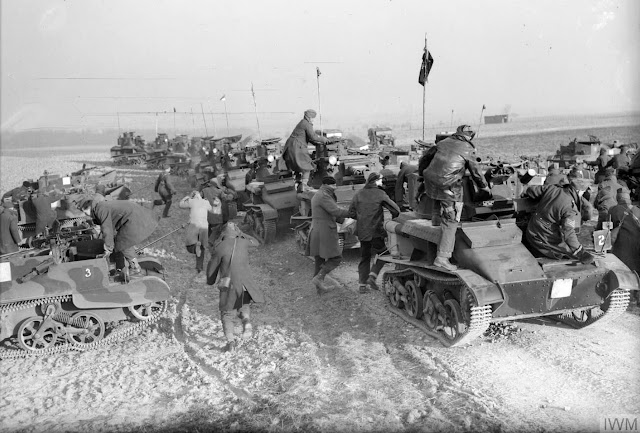 |
| Bren carriers and Light Tanks Mk VI crews of 4/7th Royal Dragoon Guards mount up during an exercise Bucquoy, France - 12 January 1940. |
 |
| Light Tank Mk VI crews of 1st Fife and Forfar Yeomanry attached to 51st (Highland) Division. France - 19 March 1940 |
 |
| Light Tank Mk VIC knocked out during an engagement on the road between Huppy and St Maxent, in the Somme sector. France - 27 May 1940 |
 |
| A French soldier talks with the commander of a British Vickers Mk VIB light tank about the combat situation, ahead. The driver seems to be concerned about the situation... France - 1940. |
%20tanks%20of%20the%207th%20Panzer%20Division%20push%20through%20a%20small%20creek%20on%20the%20way%20into%20the%20heart%20of%20France.jpg) |
| German Panzer II and Panzer 38(t) light tanks of the 7th Panzer Division push through a small creek on the way into the heart of France. May - 1940. |
 |
| Vickers light tank Mk VIB abandoned after being penetrated in the frontal armor (see perforation in the margin of the stain of the photo) being inspected by a German soldier. France - 1940. |
 |
| A damaged Vickers light tank Mk VIB from C Squadron, 9th Troop, second tank, 3rd Royal Tank Regiment. Notice the penetrations in the front base of the turret and in the cupola. Calais, France - 1940 |
 |
The same vehicle above, with German soldiers posing for photographs wrapped in .303 ammo belts. The divisional rhinoceros insignia from 1st Armoured Division it is clearly visible. Calais, France - 1940 |
 |
| Vickers light tank Mk. IV Bs destroyed by the Germans Notice the tank in the foreground bearing evidence of rear penetrations France -1940 |
 |
| Two Light tanks Mk VIB destroyed near Dunkirk, northern France - 1940 |
 |
| A Vickers light tank Mk VIB from 3rd RTR, 1st AD being inspected by a German soldier, after being abandoned, along with a Bren Carrier, stuck in the sandy terrain near Calais - 1940. |
 |
| A Light tank Mk VIB, captured by Germans in France, painted in panzer grey and with German markings, used as Leichter Panzerkampfwagen Mk. IV 734(e). |
 |
Leichter Panzerkampfwagen Mk. IV 734(e), in panzer-gray. a Vickers light tank Mk VI captured by Germans and used by Schutzpolizei des Reiches. Notice the modified gun mantlet, with a single .303 Vickers light machine gun. |
 |
| Doctor Engineer Alfred Becker 20 August 1899 - 26 December 1981 Knight’s Cross of the War Merit Cross |
%20003.jpg) |
| 10.5cm leFH 16 auf Geschutzwagen auf Fahrgestell Mk VI 736 (e) |
- Six 15cm leFH 13 auf Geschutzwagen auf Fahrgestell Mk VI 736 (e)
- Twelve Mk VI Munitionspanzer
 |
| Mk VI Munitionspanzer with ammo trailer |
- Four Mk VI Beobachtungspanzer
 |
| Mk VI Beobachtungspanzer |
 |
| Italian tank Carro Armato M11/39 and Carro Veloce L3/33 tankette North African Campaign - 1940 |
 |
| A Light tank Mk VIB from 1st RTR with a headlamp on the side of a turret cupola, crossing barbed wire somewhere in the Western desert May - 1940. |
 |
| Line of Vickers light tanks MK VIB belonging to 7th Armoured Division on patrol in open desert. 2 August 1940 |
 |
| The crew of this Vickers light tank Mk VIB posing for a photo, on a rest break in the desert. 3rd King's Own Hussars December - 1940. |
 |
| A column of Italian soldiers prisoners captured during the assault on Bardia, Libya, marching to a British army base. 6 January 1941 |
 |
| Weak armor and weaponry require a keen eye... The crew of a fully equiped light tank Mk VIB looking for any movement of the enemy, near Tobruk. 28 November 1941 |
 |
| British Light Tank Mk VIB destroyed in Galatas. The tank was one of two that supported the New Zealand counter-attack on Galatas Battle of Crete - 25 May 1941. |
 |
Light Tanks Mk VIs roaring in an exercise in Maltese road. Foreground vehicle is a Mk VIC, with a Mk VIB parking in the trees. Malta - 24 May 1942 |
 |
| A Vickers light tank Mk VIC on exercise in the Maltese countryside. Notice the typical Maltese stone camouflage 24 March 1942 |
 |
| Vickers light tank Mk VIC testing their weaponry at a Shooting Range in Malta - 24 March 1942 |
 |
| The crew of Vickers light tank Mk VIB cleaning his Vickers .50 heavy machine gun under the trees, in the Maltese countryside - May 1942 |
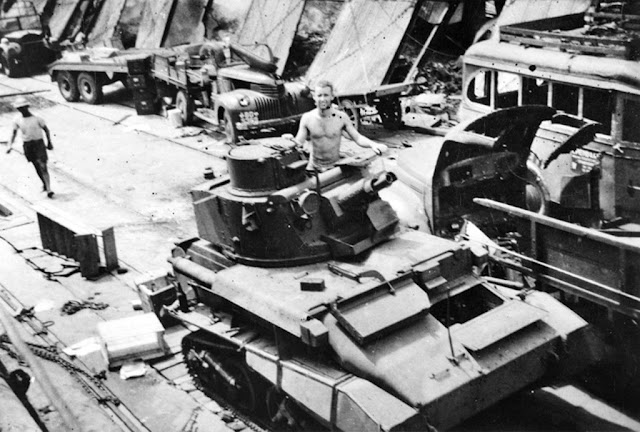 |
| A Light tank Mk.VIB from a Light Tank Squadron of the 3rd King's Own Hussars, Oosthaven, Sumatra, Netherlands East Indies - circa. 1942. |
 |
| Two Vickers light tank Mk.VIBs captured by Imperial Japanese Army with Japanese markings, found at a workshop. Bandung, Java - Indonesia - 1946 |
Specs:
| Tank, Light, Mk VI (Vickers light tank Mk VIB) | |
|---|---|
| Type | Light tank |
| Place of origin | United Kingdom |
| Service history | |
| In service | 1936–1942 (frontline) 1948 Arab–Israeli War |
| Used by | United Kingdom Australia New Zealand Canada Egypt |
| Wars | Second World War 1948 Arab–Israeli War |
| Production history | |
| Designer | Vickers-Armstrongs |
| Manufacturer | Vickers-Armstrongs |
| Produced | 1936–1940 |
| No. built | 1,682 |
| Variants | Mk VI, Mk VIA, Mk VIB Mk VIC, Ack Ack tanks |
| Specifications | |
| Mass | 4.93 t - later 5.3 t |
| Length | 4.0 m |
| Width | 2.08 m |
| Height | 2.26 m |
| Crew | 3 (commander, gunner, driver) |
| Armour | 4 - 14 mm |
Main armament | .50 in Vickers mg (Mk VIC - 15 mm Besa.mg) |
Secondary armament | .303 in Vickers mg (Mk VIC - 7.92 mm Besa mg) |
| Engine | Meadows 6-cylinder petrol 4.4 liters 88 hp (66 kW) |
| Power/weight | 16.9 hp/ton (Mark VIB and VIC) |
| Transmission | Wilson pre-selector gearbox |
| Suspension | Horstmann inclined springs |
| Ground clearance | 250 mm |
| Fuel capacity | 140 liters |
Operational range | 210 km |
| Maximum speed | 56 km/h - road 40 km/h - off road |
The kit:
 |
| The bald one getting ready for another day of work. |
 |
| The chassis bathtubs and other parts, from the parallel building of the two Vickers. One of the turrets will be anothera addition to "Kojak's Unbelievable Spare Parts Box". |
 |
| Hulls and upper decks in position. Note the unique armored air intake of the Mk VIB versions, in front of the hulls. |
 |
| The hulls almost complete. Left view. Notice the metal parts, |
 |
| The hulls almost complete. Right view. |
 |
| Oh, man!! |
 |
| Vickers-type suspension wheel alignment apparatus (worldwide patent pending) |
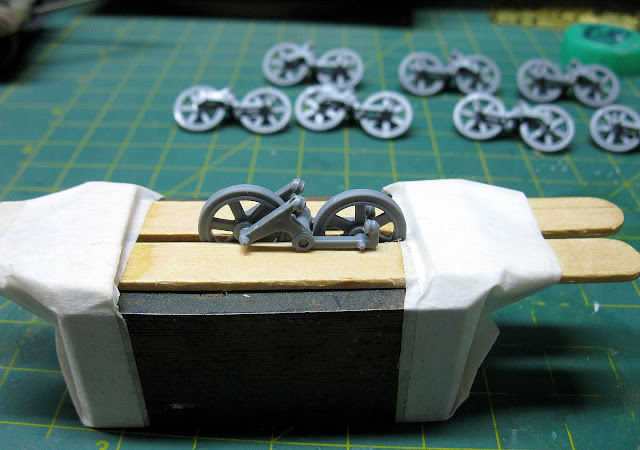 |
| Vickers-type suspension wheel alignment apparatus in action |
 |
| Wartime...mass production! Bogies ready for the springs... Important detail: The bogies must be very well glued and firm before the next step. |
 |
| The metal parts of the kit were very soft and easily bent... |
 |
| 1- Passing the steel wire freely through the holes in the arms... The springs will be inserted in the portion pointed by the blue arrow. |
 |
| 2-Testing the free movement of the steel wire... Then we reposition the wire as in the photo in step 1, above... |
 |
| 6- When releasing the tweezers, the springs occupy the empty space and we can slide the steel wire to the desired position (green and yellow arrows) Then, we cut the excesses with cutting edge pliers. |
 |
| 7- Slide the wire (green arrow) so as to leave 1mm at each free end of the steel wire (yellow), carefully cutting off the excess (red double arrow) |
 |
| 8- Glue the steel wire into position with superglue (yellow arrows). Repeat the process on the other side of the bogie and on all bogies. |
 |
| And the bogies ready for the installation... |
 |
| Vickers light tank Mk VIB, standing on its own paws!! Left view |
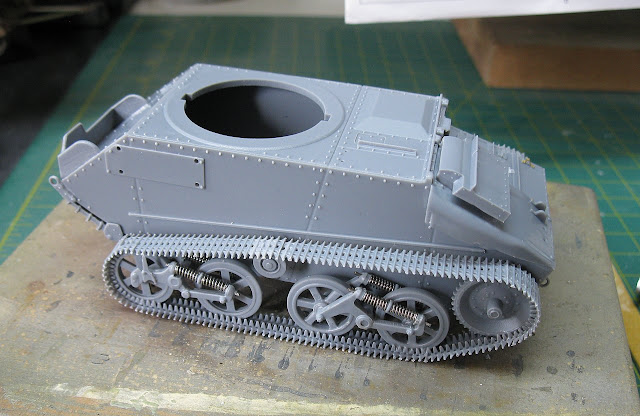 |
| Vickers light tank Mk VIB, standing on its own paws!! Right view |
 |
| The two Vickers sisters, side by side, with tracks in position... |
 |
| Removing this row of rivets for a perfect adaptation of the armored cover of the hull ventilation. |
 |
| Armored covers in position!!! Notice the fenders installed on the sides of the hulls. |
 |
| Turret and guns in position... |
 |
| Replacing the flimsy plastic with strong metal!!! |
 |
| And adding details to our model: fancy headlights!!! |
 |
| Again, the two sisters, side by side.... wearing details in metal... left side |
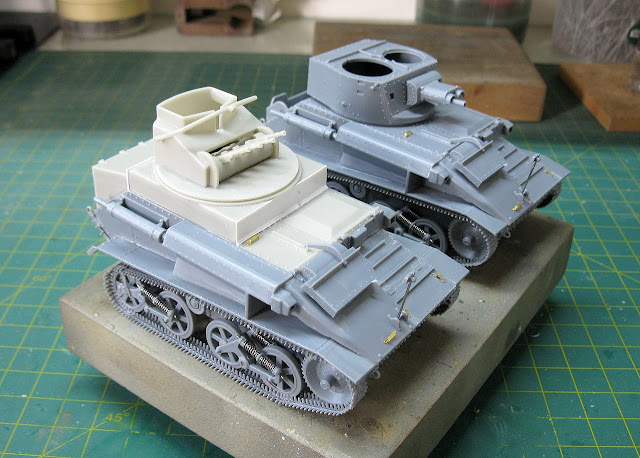 |
| The two sisters, side by side.... right side |
 |
| The two sisters, side by side.... rear view |
 |
| The two sisters, side by side.... Eeeeeyes left!!! |
 |
| It's hard to be lazy!!! |
 |
| Perfect!!! The King is pleased!! |
 |
| The Vickers is very nice with those little ears!!! |
 |
| Small details in PE... |
 |
| How cute are these light tanks!!! |
 |
| Vickers light tank Mk VIB - rear right view |
 |
| Vickers light tank Mk VIB - left view |
 |
| Vickers light tank Mk VIB - rear left view |
 |
| Vickers light tank Mk VIB - right view |
 |
| Vickers light tank Mk VIB - ready for painting... |
 |
| Vickers light tank Mk VIB and Vickers "Ack Ack" Mk II light tank left front view |
 |
| Vickers light tank Mk VIB and Vickers "Ack Ack" Mk II light tank front right view |
 |
| French farmer driving a horse-drawn cart salut the crew of Vickers light tank Mk VI B of 13th/18th Royal Hussars (Queen Mary's Own), 1st Infantry Division's Recce Regt, near Arras, 12 October 1939. colorized from IWM O 679 |
 |
| External part of decal set (D356127) from Echelon Decals. |
 |
| Echelon Decals instructions |
 |
| Shades of Bronze Green Light tank Mk VIB - left front view |
 |
| Light tank Mk VIB - left rear view |
 |
| Light tank Mk VIB - right view |
 |
| Light tank Mk VIB - right front view |
 |
| Starting the decals, after a layer of Pledge Notice the small size of census number... |
 |
| Markings in the Light tank Mk VIB - rear view |
 |
| Markings in the Light tank Mk VIB right front view |
 |
| Markings in the Light tank Mk VIB front view |
 |
| Markings in the Light tank Mk VIB close up front view |
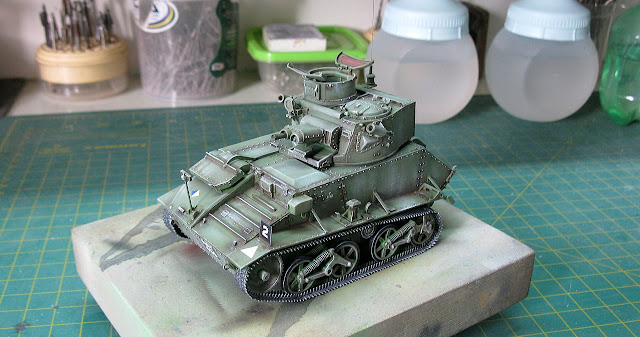 |
| After sealing the decals with matte varnish, let's start the weathering... |
 |
| The weathering will not be intense, as these vehicles have just arrived in France... |
 |
| Rear view |
 |
| Vickers light tank Mk VIB... these little tanks are very cool!!! |
 |
| I decided to add a set of roll bags to the rear rack of the tank. Value Gear to the rescue!!! |
 |
| Testing the Value Gear kit adaptation... |
 |
| And applying the primer on this and other roll bags from other projects... |
 |
| Roll Bags for the two Vickers light tanks, painted... |
 |
| Light tank MkVI B - 13th/18th Royal Hussars (Queen Mary Own) 1st Infantry Division - British Expeditionary Force (BEF). Arras - France - October, 1939 |
 |
| Light tank MkVI B front right view |
 |
| Light tank MkVI B right view |
 |
| Light tank MkVI B rear right view |
 |
| Light tank MkVI B rear left view |
 |
| Light tank MkVI B front view |
 |
| Light tank MkVI B left view |
 |
| Light tank MkVI B front left view |
 |
| I'm small, but I'm proud!!! |
 |
| Light tank MkVI B and the bald one!!! |
 |
| Light tank MkVI B - 13th/18th Royal Hussars (Queen Mary Own) 1st Infantry Division - British Expeditionary Force (BEF). Arras - France - October, 1939 |
 |
| The crew of a Light tank Mk VI of 1st Fife and Forfar Yeomanry, attached to 51st Division - France, 19 March 1940. modified from IWM photo |



%20specs.jpg)
%20specs.jpg)


%20specs.jpg)
%20specs.jpg)


%20specs.jpg)








Hi Marcos, You forget to mention which conversion kit you used for the ack ack...
ResponderExcluirHerman
Hi, Herman... Don't worry... A new article with this AA variant will be released, soon!! Stay tuned, my friend!!!
ExcluirExcelente Marco, como siempre, estupendo la reseña historica, y doblemente excelente lo de los palitos de helado (tenes que patentarla), espero el siguiente capitulo.
ResponderExcluirExcellent Marco, as always, great historical review, and doubly excellent about the ice cream sticks (you have to patent it), I look forward to the next chapter.
Jose
Hola, Jose... gracias, hombre!!! Si...Construir maquetas, además de ser divertido, también despierta en nosotros cierto espíritu de invención, de improvisación. Creo que todo esto hace que nuestra afición sea aún más fascinante... Y estad atentos: se vienen más cosas buenas. ¡¡¡Un gran abrazo!!!"
ExcluirHi, what an amazing collection of information. I am just writing on Twitter a little bit about the Mark VI.
ResponderExcluirYou include a photo of "A Vickers light tank Mk VIB from 3rd RTR, 1st AD being inspected by a German soldier, after being abandoned, along with a Bren Carrier, stuck in the sandy terrain around the beaches of Dunkirk - 1940."
But I think this must be at Calais. I have just been reading Patrick Delaforce's book about 3 RTR and I don't think they got anywhere NEAR Dunkirk.
Hi, Anonimous... Thanks for your correction: text fixed... Thank you very much my friend...Check back often!!
Excluir